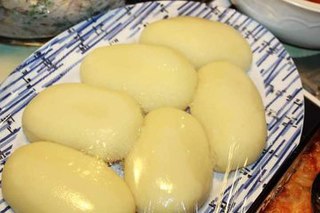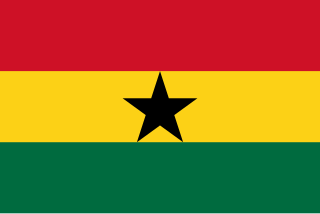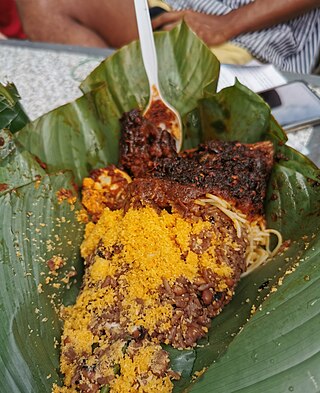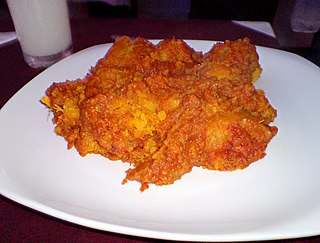
Fufu is a pounded meal found in West African cuisine. It is a Twi word that originates from the Akans in Ghana. The word has been expanded to include several variations of the pounded meal found in other African countries including Sierra Leone, Liberia, Cote D'Ivoire, Burkina Faso, Benin, Togo, Nigeria, Cameroon, the Democratic Republic of Congo, the Central African Republic, the Republic of Congo, Angola and Gabon. It also includes variations in the Greater Antilles and Central America, where African culinary influence is high.

Àmàlà is a staple swallow food originating from Nigeria popularized by the Yoruba ethnic group of southwestern Nigeria and other parts of Yorubaland. It is made of yam, cassava flour, or unripe plantain flour. Tubers of yams are peeled, sliced, cleaned, dried and then ground into flour. It is also called èlùbọ́. Yams are white in colour but turn brown when dried which gives àmàlà its colour. It is a popular side dish served with ewédú and gbẹ̀gìrì, but is also served with a variety of other ọbè (soups), such as ẹ̀fọ́, ilá, and ogbono.

Ghanaian cuisine refers to the meals of the Ghanaian people. The main dishes of Ghana are centered around starchy staple foods, accompanied by either a sauce or soup as well as a source of protein. The primary ingredients for the vast majority of soups and stews are tomatoes, hot peppers, and onions. As a result of these main ingredients, most Ghanaian jollof rice, soups, and stews appear red or orange.

Palaver sauce or palava sauce or plasas is a type of stew widely eaten in West Africa, including Ghana, Liberia, Sierra Leone The word palaver comes from the Portuguese language and means a talk, lengthy debate or quarrel. It is unclear how this led to the name of the stew. One theory is that the spices used in the stew mingle together like raised voices in an argument. It has been thought of as having the power to calm tensions, or to cause them. Other names for the dish include kontonmire, kentumere, nkontommire and pla'sas.

West African cuisine encompasses a diverse range of foods that are split between its 16 countries. In West Africa, many families grow and raise their own food, and within each there is a division of labor. Indigenous foods consist of a number of plant species and animals, and are important to those whose lifestyle depends on farming and hunting.

Nigerian cuisine consists of dishes or food items from the hundreds of Native African ethnic groups that comprises Nigeria. Like other West African cuisines, it uses spices and herbs with palm oil or groundnut oil to create deeply flavored sauces and soups.

Waakye or Awaakye is a Ghanaian dish of cooked rice and beans, commonly eaten for breakfast or lunch. However, others eat it for supper. The rice and beans, usually black eyed peas or cow beans, are cooked together, along with red dried sorghum leaf sheaths or stalks and limestone. The sorghum leaves and limestone give the dish its characteristic flavor and a red appearance and the sorghum is taken out before consumption. The word waakye is from the Dagbani language, and refer to a particular type of beans. In Hausa, the bean and the dish are called wake, a contracted form of the full name shinkafa da wake which means rice and beans.

Koobi is the Akan name for salted, dried tilapia originating from Ghana. The fish has an indigenous flavor in stews and soup in the Ghanaian local delicacies. It is used to prepare Ghanaian foods such as garden egg stew, okro stew, kontomire stew and other local Ghanaian cuisines.

Peanut soup or groundnut soup is a soup made from peanuts, often with various other ingredients. It is a staple in African cuisine but is also eaten in East Asia (Taiwan), the United States and other areas around the world. It is also common in some regions, such as Argentina's northwest, Bolivia and Peru, where it can sometimes be served with bone meat and hollow short pasta or fries. In Ghana it is often eaten with fufu, omo tuo and banku and is often very spicy. Groundnut soup is also a native soup of the Benin (Edo) people in Nigeria and it is often eaten with pounded yam. Some of the essential ingredients used in making it are ugu, oziza leaves, Piper guineense and Vernonia amygdalina.

In Ghanaian cuisine, banku and akple are swallow dishes made of a slightly fermented cooked mixture of maize and cassava doughs formed into single-serving balls.
Moesha Buduong is a Ghanaian TV presenter, actress, and model who is also known for granting a controversial interview to CNN reporter Christiane Amanpour on issues of sex, love, and gender. She is a top entertainer in Ghana's television and movie industries.
Abunuabunu is a soup from the Brong Ahafo Region of Ghana. It is made from cocoyam leaves together with other ingredients.

Gari and beans is a type of dish made of staple foods in Ghana. It is usually common in the southern parts of Ghana popularly called 'gobɛ, yo ke gari and even red red.

Braised rice is a Ghanaian style of cooking rice. It is known as angwa moo in the Akan language, literally "oil rice" or omɔ kɛ fɔ(omor ker for) in the Ga language. It is prepared with few ingredients. and is usually balanced with some vegetables and any other accompaniment to balance the diet. The braised rice is served with ground pepper or shito, and served with fried eggs, omelette or sardine.

Koko is a spicy millet porridge. It is a popular Nigerian and Ghanaian street food and commonly consumed as a breakfast meal. It can also be taken in late afternoon as snack. Koko is made from many grains including millet with a few local spices added to give it a particular taste and color. It is called Hausa koko in areas where it was introduced by Hausa-speaking people. In northern Ghana, the term 'Hausa koko' is not used. Instead, porridge made from millet is called 'za koko' in Dagbanli. Several types of porridge are made from corn, millet, and sorghum. Other types of porridge include koko talli/salli, zimbuli, among others. It is also common in the various communities in both countries.

Mpoto Mpoto is a Ghanaian cuisine made from cocoyam or yam. It is also known as Yam Pottage and Asaro by Nigerians. It is made from several ingredients including fish and onion.

Wasawasa is a popular dish, eaten in Dagbon and other parts of Northern Ghana. It is also eaten in some West African countries, such as Burkina Faso, Benin, Nigeria etc. It is made from dried yam peelings called jaling, which have been grounded into flour and steamed. Wasawasa is mostly eaten with spicy sauces and sometimes garnished with vegetables, accompanied with shea butter or raw groundnut oil and fried fish. Wasawasa is sometimes served with beans, pasta, and salad.
The Chop Bar is a Ghanaian food centre that serves local cuisines in a contemporary dining setting. It was founded by Elias Hage and Mona Quartey El Halabi in 2015















